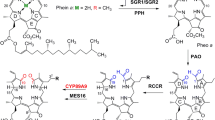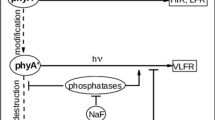Abstract
The aurea and yellow-green-2 (yg-2) mutants of tomato (Solanum lycopersicum) are unable to synthesize the phytochrome chromophore from heme resulting in a block of this branch of the tetrapyrrole pathway. We have previously shown that these mutants also exhibit an inhibition of protochlorophyllide (Pchlide) synthesis and it has been hypothesised that this is due to feedback inhibition by heme on the synthesis of 5-aminolevulinic acid (ALA). In this study we have investigated Pchlide reaccumulation in cotyledons from etiolated wild-type (WT), aurea and yg-2 seedlings using low-temperature fluorescence spectroscopy. WT cotyledons showed two characteristic Pchlide emission maxima at 630 nm (F630) and 655 nm (F655) respectively, while the aurea and yg-2 mutants contained only phototransformable Pchlide F655. Following a white-light flash to WT cotyledons, reaccumulation of phototransformable Pchlide F655 in the first 30 min was absolutely dependent on the presence of Pchlide F630 before the flash. Reaccumulation of Pchlide F630 was not apparent until at least 2 h after the phototransformation. In contrast, Pchlide F630 never accumulated in aurea cotyledons. The relative rates of both Pchlide F655 and total Pchlide synthesis were approximately twice as high in WT compared to aurea. Measurement of ALA synthesis capacity during this period showed that the reduced rate of Pchlide reaccumulation in aurea was due to an inhibition at this step of the pathway. In addition, feeding of ALA resulted in a substantial and equal increase of non-phototransformable Pchlide in both WT and aurea indicating that aurea cotyledons are capable of accumulating high levels of Pchlide that is not associated to the active site of NADPH:Pchlide oxidoreductase (POR). The implications of these results for the mechanism of inhibition of Pchlide synthesis in phytochrome chromophore-deficient mutants and the role of non-phototransformable Pchlide F630 during plastid development are discussed.
Similar content being viewed by others
References
Beale SI (1999) Enzymes of chlorophyll biosynthesis. Photosynth Res 60: 43–73
Beale SI and Weinstein JD (1991) Biochemistry and regulation of photosynthetic pigment formation in plants and algae. In: Jordan PM (ed) Biosynthesis of Tetrapyrroles, pp 155–235. Elsevier, Amsterdam
Böddi B, Ryberg M and Sundqvist C (1992) Identification of four universal protochlorophyllide forms in dark-grown leaves by analyses of the 77 K fluorescence emission spectra. J Photochem Photobiol B Biol 12: 389–401
Davis SJ, Kurepa J and Vierstra RD (1999) The Arabidopsis thaliana HY1 locus, required for phytochrome-chromophore biosynthesis, encodes a protein related to heme oxygenases. Proc Natl Acad Sci USA 96: 6541–6546
Ford MJ and Kasemir H (1980) Correlation between 5-aminolevulinate accumulation and protochlorophyll photoconversion. Planta 150: 206–210
Griffiths WT (1991) Protochlorophyllide photoreduction. In: Scheer H (ed) Chlorophylls, pp 587–612. CRC Press, Boca Raton, Florida
Kerckhoffs LHJ, Kelmenson PM, Schreuder MEL, Kendrick CI, Kendrick RE, Hanhart CJ, Koornneef M, Pratt LH and Cordonnier-Pratt M-M (1999) Characterization of the gene encoding the apoprotein of phytochrome B2 in tomato, and identification of molecular lesions in two mutant alleles. Mol Gen Genet 261: 901–907
Klein S, Katz E and Neeman E (1977) Induction of ?-aminolevulinic acid formation in etiolated maize leaves controlled by two light systems. Plant Physiol 60: 335–338
Kohchi T, Mukougawa K, Frankenberg N, Masuda M, Yokota A and Lagarias JC (2001) The Arabidopsis HY2 gene encodes phytochromobilin synthase, a ferredoxin-dependent biliverdin reductase. Plant Cell 13: 425–436
Koornneef M, Rolff E and Spruitt CJP (1980) Genetic control of light-inhibited hypocotyl elongation in Arabidopsis thaliana L. Heynh. Z Pflanzenphysiol 100: 147–160
Koornneef M, Cone JW, Dekens RG, O'Herne-Robers EG, Spruit CJP and Kendrick RE (1985) Photomorphogenic responses of long-hypocotyl mutants of tomato. J Plant Physiol 120: 153–165
Kruse E, Grimm, B, Beator J and Kloppstech K (1997) Developmental and circadian control of the capacity for ?-aminolevulinic acid synthesis in green barley. Planta 202: 235–241
Meskauskiene R, Nater M, Goslings D, Kessler F, op den Camp R and Apel K (2001) FLU: a negative regulator of chlorophyll biosynthesis in Arabidopsis thaliana. Proc Natl Acad Sci USA 98: 12826–12831
Muramoto T, Kohchi T, Yokota A, Hwang I and Goodman HM (1999) The Arabidopsis photomorphogenic mutant hy1 is deficient in phytochrome chromophore biosynthesis as a result of a mutation in a plastid heme oxygenase. Plant Cell 11: 335–347
Papenbrock J and Grimm B (2001) Regulatory network of tetrapyrrole biosynthesis-studies of intracellular signalling involved in metabolic and developmental control of plastids. Planta 213: 667–681
Ryberg M and Sundqvist C (1991) Structural and functional significance of pigment-protein complexes of chlorophyll precursors. In: Scheer H (ed) Chlorophylls, pp 587–612. CRC Press, Boca Raton, Florida
Stobart AK and Amenn-Bukhari I (1984) Regulation of ?-aminolaevulinic acid synthesis and protochlorophyllide regeneration in the leaves of dark-grown barley (Hordeum vulgare) seedlings. Biochem J 222: 419–426
Sundqvist C and Dahlin C (1997) With chlorophyll pigments from prolamellar bodies to light-harvesting complexes. Physiol Plant 100: 748–759
Terry MJ (1997) Phytochrome chromophore-deficient mutants. Plant Cell Environ 20: 740–745
Terry MJ and Kendrick RE (1996) The aurea and yellow-green-2 mutants of tomato are deficient in phytochrome chromophore synthesis. J Biol Chem 271: 21681–21686
Terry MJ and Kendrick RE (1999) Feedback inhibition of chlorophyll synthesis in the phytochrome chromophore-deficient aurea and yellow-green-2 mutants of tomato. Plant Physiol 119: 143–152
Terry MJ, Wahleithner JA and Lagarias JC (1993) Biosynthesis of the plant photoreceptor phytochrome. Arch Biochem Biophys 306: 1–15
Terry MJ, McDowell MD and Lagarias JC (1995) (3Z)-and (3E)-phytochromobilin are intermediates in the biosynthesis of the phytochrome chromophore. J Biol Chem 270: 11111–11119
Terry MJ, Ryberg M, Raitt CE and Page AM (2001) Altered etioplast development in phytochrome chromophore-deficient mutants. Planta 214: 314–325
Urata G and Granick S (1963) Biosynthesis of ?-aminoketones and the metabolism of aminoacetone. J Biol Chem 238: 811–820
Vothknecht UC, Kannangara CG and von Wettstein D (1998) Barley glutamyl tRNAGlu reductase: mutations affecting haem inhibition and enzyme activity. Phytochemistry 47: 513–519
Weller JL, Terry MJ, Rameau C, Reid JB and Kendrick RE (1996) The phytochrome-deficient pcd1 mutant of pea is unable to convert heme to biliverdin IX?. Plant Cell 8: 55–67
Weller JL, Terry MJ, Reid JB and Kendrick RE (1997) The phytochrome-deficient pcd2 mutant of pea is unable to convert biliverdin IX? to 3(Z)-phytochromobilin. Plant J 11: 1177–1186
Author information
Authors and Affiliations
Corresponding author
Rights and permissions
About this article
Cite this article
Ryberg, M., Terry, M.J. Analysis of protochlorophyllide reaccumulation in the phytochrome chromophore-deficient aurea and yg-2 mutants of tomato by in vivo fluorescence spectroscopy. Photosynthesis Research 74, 195–203 (2002). https://doi.org/10.1023/A:1020911727791
Issue Date:
DOI: https://doi.org/10.1023/A:1020911727791




